My apiary
The map shows demo apiaries in the CAVAT system. Apiaries data could be used in the study and prevention of varroa reinvasion. We will demonstrate the use of location data in a model that determines the invasive potential of the apiary.
The model presented has no basis in the literature. It is founded exclusively on assumptions that have not been proven.
The invasion of varroa depends on many factors. Only placement of apiaries in the environment (apiaries topology) is considered in this model. Other possible factors such as the number of colonies in apiary, colony strenght, swarming etc. are not considered.
Apiaries on the map are represented by coloured circles. When clicked, you get info about apiary invasion potential and circles in a 3 km (red) and 6 km (blue) radius. Delete circles with F5. You can check apiary invasion potential according to the rules explained in Apiary invasion potential rules.

In figure 1 are two apiaries 2 km apart. Varroa can pass from apiary A to apiary B. Let's define this capability as transfer potential and denote it as: TAB.
Rules
- Capability of varroa passing between apiary A and apiary B is transfer potential TAB.
For purpose of this model we assign transfer potential value 1.
Rules
- Capability of varroa passing between apiary A and apiary B is transfer potential TAB.
- Value of transfer potential is 1: TAB = 1.
Varroa can be pass from apiary A to apiary B and vice versa. Since we consider both apiaries as equal, same rules apply for both A and B.
Rules
- Capability of varroa passing between apiary A and apiary B is transfer potential TAB.
- Value of transfer potential is 1: TAB = 1.
- Transfer potential is equal in both directions : TAB = TBA.
Varroa can pass between apiaries if apiaries are not to apart. Let's set this distance to 3000 meters.
Rules
- Capability of varroa passing between apiary A and apiary B is transfer potential TAB.
- Value of transfer potential is 1: TAB = 1.
- Transfer potential is equal in both directions : TAB = TBA.
- Varroa can pass only between apiaries less than 3 km apart.
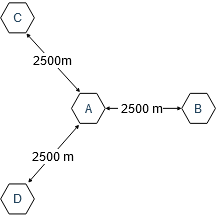
In figure 2 are four apiaries. Apiary A is within 3 km range of apiaries B, C and D. Apiaries B, C and D are more than 3 km apart from each other.
Varroa can pass from apiary A to apiary B, C and D and vice versa. However, it can't pass between apiaries B, C and D (rule 4).
Transfer potentials are (rules 2 and 3):
- TAB = TBA = 1.
- TAC = TCA = 1.
- TAD = TDA = 1.
Let's name capability of apiary A to pass varroa to other apiaries as apiary invasion potential and denote it as IA.
Rules
- Capability of varroa passing between apiary A and apiary B is transfer potential TAB.
- Value of transfer potential is 1: TAB = 1.
- Transfer potential is equal in both directions : TAB = TBA.
- Varroa can pass only between apiaries less than 3 km apart.
- Capability of apiary A to pass varroa to other apiaries is apiary invasion potential. IA.
Apiary A can infest 3 apiaries and can be infested by 3 apiaries. Apiaries B, C and D can infest only apiary A and can be infested only by apiary A.
We define apiary invasion potential as sum of its transfer potentials.
Calculated transfer and invasion potentials are in figure 3:
- IA = TAB + TAC + TAD= 3
- IB = TBA = 1
- IC = TCA = 1
- ID = TDA = 1
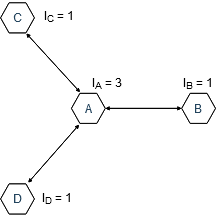
Rules
- Capability of varroa passing between apiary A and apiary B is transfer potential TAB.
- Value of transfer potential is 1: TAB = 1.
- Transfer potential is equal in both directions : TAB = TBA.
- Varroa can pass only between apiaries less than 3 km apart.
- Capability of apiary A to pass varroa to other apiaries is apiary invasion potential. IA.
- Apiary invasion potential is sum of its transfer potentials.

In figure 4 are three apiaries: A, B and C. Varroa can pass from A to B and from B to C (rule 1). Actually varroa can pass between two apiaries more than 3 km apart (rule 4 is violated).
We need to modify set of rules.
In order varroa to pass from apiary A to B, obviouslly there must be varroa in A. If there is only small number of varroa in A it is unlikelly it will pass to B. We assume there should be a critical number of varroa in A in order to pass to B.
In newly infested apiary B varroa needs certain amount of time to develop above crtitical level. Only after that time it can propagate from B to C. Time plays critical role in invasion propagation.
Varroa will spread across all apiaries if they are not treated against varoa. Model and rules presented here have sense only if we assume all apiaries are periodically and simultaneouslly treated against varroa and this treatment lower varroa level below critical.
Assumptions
- All apiaries in region are periodically and simultanouslly treated against varroa.
- After treatment varroa level is below critical.
Rules
- Capability of varroa passing between apiary A and apiary B is transfer potential TAB.
- Value of transfer potential is 1: TAB = 1.
- Transfer potential is equal in both directions : TAB = TBA.
- Varroa can pass only between apiaries less than 3 km apart.
- Capability of apiary A to pass varroa to other apiaries is apiary invasion potential. IA.
- Apiary invasion potential is sum of its transfer potentials.
-
Varroa can pass between two apiaries A and C more than 3 km apart if both conditions are met:
- There is at least one intermediate apiary B, which is less than 3 km apart from both apiaries A and C.
- Varroa in newly infested intermediate apiary B has enough time to develop over critical level.
In figure 4 are three apiaries: A, B and C. Varroa can pass directly from A to B and then propagate further to C after a while.
Let's call varroa passing from A to B direct transfer in first step. Propagation from A to C is indirect varroa transfer in second step. Imagine we "walk" forward to adjacent apiaries from A to B, from B to C and so on. How many steps should be included in calculating invasion potential ?
We assumed colonies are treated periodically and simultanously. Period between two treatments determines how far can varroa invasion propagate.
In our model we consider direct transfer and indirect transfer up to second step. Apiaries from second step also have lower transfer potential with value 0.3 because they less significantly impact varroa level.
In set of rules we modify terminology to distinguish between direct and indirect varroa passing between apiaries.
Assumptions
- All apiaries in region are periodically and simultanouslly treated against varroa.
- After treatment varroa level is below critical.
Rules
- Capability of varroa passing between apiary A and apiary B is transfer potential TAB.
- Value of direct transfer potential is 1 : TAB = 1.
- Transfer potential is equal in both directions : TAB = TBA.
- Varroa can pass directly only between apiaries less than 3 km apart.
- Capability of apiary A to pass varroa to other apiaries is apiary invasion potential. IA.
- Apiary invasion potential is sum of its transfer potentials.
-
Varroa can pass indirectly between two apiaries A and C more than 3 km apart if both conditions are met:
- There is at least one intermediate apiary B, which is less than 3 km apart from both apiaries A and C.
- Varroa in newly infested intermediate apiary B has enough time to develop over critical level.
- Value of indirect transfer potential in second step is 0.3: TAC = 0.3
Example in figure 5 shows apiaries with their invasion potential. Let's calculate transfer potentials for each apiary and sum them to get apiary invasion potential.
Final set of assumptions and rules
Assumptions
- All apiaries in region are periodically and simultanouslly treated against varroa.
- After treatment varroa level is below critical.
Rules
- Capability of varroa passing between apiary A and apiary B is transfer potential TAB.
- Value of direct transfer potential is 1 : TAB = 1.
- Transfer potential is equal in both directions : TAB = TBA.
- Varroa can pass directly only between apiaries less than 3 km apart.
- Capability of apiary A to pass varroa to other apiaries is apiary invasion potential. TA.
- Apiary invasion potential is sum of its transfer potentials.
-
Varroa can pass indirectly between two apiaries A and C more than 3 km apart if both conditions are met:
- There is at least one intermediate apiary B, which is less than 3 km apart from both apiaries A and C.
- Varroa in newly infested intermediate apiary B has enough time to develop over critical level.
- Value of indirect transfer potential in second step is 0.3: TAC = 0.3
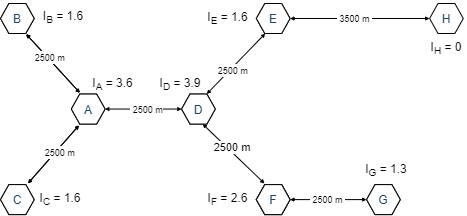
- IA = TAB + TAC + TAD+ TAE + TAF= 1 + 1 + 1 + 0.3 + 0.3 = 3.6
- IB = TBA + TBC + TBD = 1 + 0.3 + 0.3 = 1.6
- IC = TCA + TCB + TCD = 1 + 0.3 + 0.3 = 1.6
- ID = TDA + TDE + TDF + TDB + TDC+ TDG =3.9
- IE = TED + TEA + TEF = 1.6
- IF = TFD + TFG + TFA + TFE= 2.6
- IG = TGF + TGD = 1.3
- IH = 0
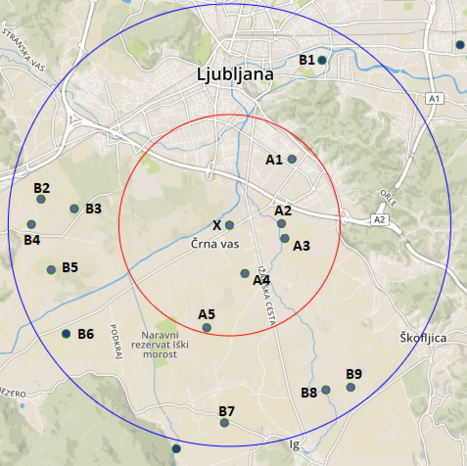
We will calculate apiary X invasion potential.
In figure 1 is apiary X with its surrounding apiaries A1 - A5 and B1 - B9.
Apiaries A1 - A5 within red circle are less than 3000 meters away from X1.
Trasfer potentials have all same value of 1.
TXA1 = TXA2 = TXA3 = TXA4 = TXA5 = 1
Apiaries B1 - B9 within blue circle, but outside red circle, are between 3001 and 6000 meters away.
Apiaries B1 - B9 will contribute to apiary X invasion potential only if there is at least one intermediate apiary. In figure 1 it is obvious there is no intermediate apiary between X and B2 - B5.
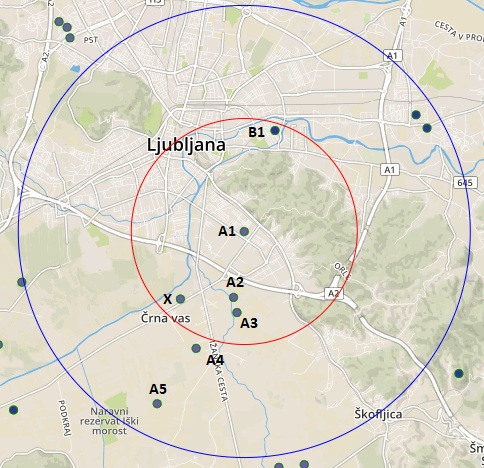
A1 could be intermediate apiary between X and B1 - we have to check if it is. Click on A1 (figure 2).
Both B1 and X are less than 3000 meters away from A1. A1 is intermediate apiary between X and B1 and B1 indirect transfer potential has value of 0.3.
TXB1 = 0.3
From figure 1 we estimate that A5 could be intermediate apiary for B6 - B9 so we need to check A5. Figure 3 shows that A5 is intermediate only for B7, which will contribute its indirect transfer potential 0.3.(figure 3)
TXB7 = 0.3
Apiaries B6, B8 and B9 do not contribute to apiary X invasion potential.
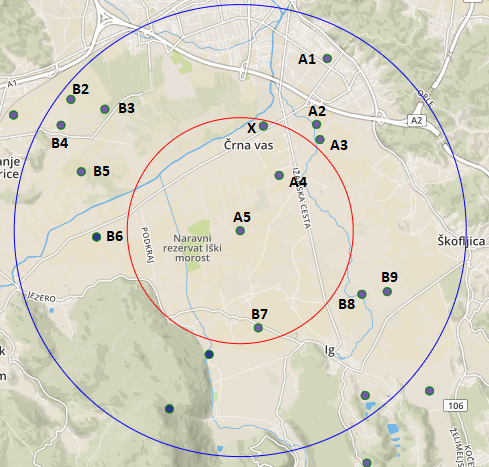
Apiary X invasion potential is sum of its transfer potentials:
IX = TXA1 + TXA2 + TXA3 + TXA4 + TXA5 + TXB1 + TXB7 = 5.6
Apiary X invasion potential is 5.6.
The model demonstrates the potential usage of data from the CAVAT system. Data collected could be beneficial in defining strategies against varroa reinvasion and managing colonies treatment.